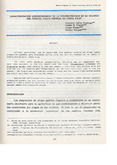Mostrar el registro sencillo del ítem
Caracterización agroeconómica de la fitoprotección en el cultivo del tomate, Valle Central de Costa Rica
| dc.contributor.author | Calvo Domingo, G. | |
| dc.contributor.author | French, J.B. | |
| dc.contributor.author | Siman, J. | |
| dc.contributor.author | Kooper, N. | |
| dc.date.accessioned | 2015-03-19T21:02:24Z | |
| dc.date.available | 2015-03-19T21:02:24Z | |
| dc.date.issued | 1990-03 | |
| dc.identifier | 473175 | es_ES |
| dc.identifier.issn | 1016-0469 | es_ES |
| dc.identifier.uri | https://repositorio.catie.ac.cr/handle/11554/5860 | |
| dc.description | Ilus. 1 tab. 18 ref. 16 pág. | es_ES |
| dc.description.abstract | Se realizó un trabajo de evaluación del cultivo de tomate en la zona de Alajuela, Grecia y Sarchí, Costa Rica. Se visitaron semanalmente 31 agricultores, durante las épocas de siembra, seca y lluviosa. Se les tomó información de las actividades realizadas, productos utilizados y otros aspectos generales.Existen tres sitemas de siembra, en monocultivo, con caña y con café. Las principales plagas reportadas fueron: en verano los insectos, principalmente gusanos de fruto (K. lycopersicella, H. zea y Spodoptera spp.), en invierno los hongos, principalmente los tizones (P. infestans y A. solani). Se encontraron diferencias estadísticamente significativas en los costos de producción debido a la época, al sistema de siembra y a la interacción entre estos dos factores. También se encontraron diferencias estadísticas significativas en la variable costos totales de la fitoprotección debido a la época, donde el mayor gasto se da en invierno. Cultural activities, use of pesticides and general aspects of three tomato production systems were evaluated during both wet and dry seasons on 31 farms in Grecia and Naranjo, Costa Rica. The insect pests Keiferia lycopersicella, Heliothis zea and Spodoptera spp. were most abundant in the dry season and the fungi Phytopththora infestans and Alternatia solani most severe in the wet season. Statistical differences were found in total production costs between seasons, production systems and the interaction, differences were also found in variable total costs of plant protection according to season, and net benefits because of interaction between season and production system. | es_ES |
| dc.format.mimetype | ||
| dc.language.iso | es | es |
| dc.publisher | CATIE, Turrialba (Costa Rica) | es_ES |
| dc.relation.ispartof | Manejo Integrado de Plagas y Agroecología Número 15 (Marzo 1990) | |
| dc.rights.uri | https://creativecommons.org/licenses/by-nc-nd/4.0/ | |
| dc.subject | METODOS DE CULTIVO | |
| dc.subject | FECHA DE SIEMBRA | |
| dc.subject | ESTACION SECA | |
| dc.subject | ESTACION HUMEDA | |
| dc.subject | INSECTICIDAS | |
| dc.subject | FUNGICIDAS | |
| dc.subject | CONTROL QUIMICO | |
| dc.subject | CONTROL DE PLAGAS | |
| dc.subject | DOSIS DE APLICACION | |
| dc.subject | PROTECCION DE LAS PLANTAS | |
| dc.subject | COSTOS DE PRODUCCION | |
| dc.subject | COSTA RICA | |
| dc.subject | LYCOPERSICON ESCULENTUM | es_ES |
| dc.title | Caracterización agroeconómica de la fitoprotección en el cultivo del tomate, Valle Central de Costa Rica | es_ES |
| dc.type | Artículo | es_ES |
| dc.journal.issueNumber | 15 | |
| dc.journal.pages | 67-82 |



